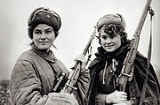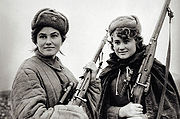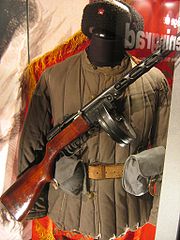
Telogreika
Encyclopedia
Telogreika is a type of winter uniform
first issued by the Red Army
during the German-Soviet War. Telogreikas continued to be issued until the late 1960s.

 The basic cut
The basic cut
the uniform followed was that of a quilted jacket
and quilted trousers
. The trousers had a button fly
and tied at the bottom of the legs. There were usually pocket
s on the hips of telogreika trousers and a button pocket on the front of the trouser leg.
Telogreika jackets buttoned up the front, and the jacket sleeves buttoned closed. Early issue variants had high collars, though these were absent later on. Telogreika jackets usually had a single pocket on the front of the jacket.
The clothing was usually khaki
in colour, although black uniforms were issued to tank crews and some grey variants can be seen, sewn of cotton
(and later polyester
-blend) fabric with a cotton wool batting
inside.
The jacket and trousers usually had a rib
bed design with the quilting, although this feature was absent on many of the non-Soviet issue uniforms
. When worn with valenki
and an ushanka
a wearer can comfortably remain warm in sub-zero temperatures for long periods. This made it the perfect uniform not just for the Red Army
, but for both prisoners and guards at the Gulag
.
during the Winter War
with Finland
, the Soviet military found their issued uniform less well suited to fighting in the Arctic and quickly copied the design.
In contrast to the usual shortages in the Red Army
, troops received regular issues of winter clothing, as their combat effectiveness could be hampered in cold conditions otherwise. The Wehrmacht
also regularly made use of captured Red Army winter uniforms, often stealing them from the deceased, due to the ineffectiveness of their own winter uniforms.
The Telogreika faded from military issue in the early 1960s
, being largely replaced by the return to the old woollen Shinel Greatcoat
and the Bushlat. In the early 1980s
the introduction of the Afghanka
field uniform marked the dawn of a new era in the Soviet Army
. Today, the Telogreika is still used in Russia
and many Soviet Bloc countries by private citizens. In Russia
it is particularly popular amongst night watchmen and workers in the construction industry.
Uniform
A uniform is a set of standard clothing worn by members of an organization while participating in that organization's activity. Modern uniforms are worn by armed forces and paramilitary organizations such as police, emergency services, security guards, in some workplaces and schools and by inmates...
first issued by the Red Army
Red Army
The Workers' and Peasants' Red Army started out as the Soviet Union's revolutionary communist combat groups during the Russian Civil War of 1918-1922. It grew into the national army of the Soviet Union. By the 1930s the Red Army was among the largest armies in history.The "Red Army" name refers to...
during the German-Soviet War. Telogreikas continued to be issued until the late 1960s.
Variations


Cut (clothing)
Cut in clothing, sewing and tailoring, is the style or shape of a garment as opposed to its fabric or trimmings.The cut of a coat refers to the way the garment hangs on the body based on the shape of the fabric pieces used to construct it, the position of the fabric's grain line, and so on....
the uniform followed was that of a quilted jacket
Jacket
A jacket is a hip- or waist-length garment for the upper body. A jacket typically has sleeves, and fastens in the front. A jacket is generally lighter, tighter-fitting, and less insulating than a coat, which is outerwear...
and quilted trousers
Trousers
Trousers are an item of clothing worn on the lower part of the body from the waist to the ankles, covering both legs separately...
. The trousers had a button fly
Fly (clothing)
A fly on clothing is a covering over an opening join concealing the mechanism, such as a zip, velcro or buttons, used to join the opening. The term is most frequently applied to a short opening over the groin in trousers, shorts and other garments, which makes them easier to put on or take off and...
and tied at the bottom of the legs. There were usually pocket
Pocket
A pocket is a bag- or envelope-like receptacle either fastened to or inserted in an article of clothing to hold small items. Pockets may also be attached to luggage, backpacks, and similar items...
s on the hips of telogreika trousers and a button pocket on the front of the trouser leg.
Telogreika jackets buttoned up the front, and the jacket sleeves buttoned closed. Early issue variants had high collars, though these were absent later on. Telogreika jackets usually had a single pocket on the front of the jacket.
The clothing was usually khaki
Khaki
This article is about the fabric. For the color, see Khaki . Kaki, another name for the persimmon, is often misspelled "Khaki".Khaki is a type of fabric or the color of such fabric...
in colour, although black uniforms were issued to tank crews and some grey variants can be seen, sewn of cotton
Cotton
Cotton is a soft, fluffy staple fiber that grows in a boll, or protective capsule, around the seeds of cotton plants of the genus Gossypium. The fiber is almost pure cellulose. The botanical purpose of cotton fiber is to aid in seed dispersal....
(and later polyester
Polyester
Polyester is a category of polymers which contain the ester functional group in their main chain. Although there are many polyesters, the term "polyester" as a specific material most commonly refers to polyethylene terephthalate...
-blend) fabric with a cotton wool batting
Batting (material)
Batting is a layer of insulation used in quilting between a top layer of patchwork and a bottom layer of backing material. Batting is usually made of cotton, polyester, and/or wool....
inside.
The jacket and trousers usually had a rib
Rib
In vertebrate anatomy, ribs are the long curved bones which form the rib cage. In most vertebrates, ribs surround the chest, enabling the lungs to expand and thus facilitate breathing by expanding the chest cavity. They serve to protect the lungs, heart, and other internal organs of the thorax...
bed design with the quilting, although this feature was absent on many of the non-Soviet issue uniforms
Effectiveness
The telogreika was particularly effective at keeping the wearer warm in the harsh Russian WinterRussian Winter
The Russian Winter is a common explanation for military failures of invaders in Russia. Common nicknames are General Frost, General Winter and General Snow. Another was "General Mud"....
. When worn with valenki
Valenki
Valenki are traditional Russian winter footwear, essentially felt boots: the name valenok literally means "made by felting". Valenki are made of wool felt. They are not water-resistant, and are often worn with galoshes to keep water out and protect the soles from wear and tear...
and an ushanka
Ushanka
An ushanka , also known as a trooper, is a Russian fur cap with ear flaps that can be tied up to the crown of the cap, or tied at the chin to protect the ears, jaw and lower chin from the cold. The thick dense fur also offers some protection against blunt impacts to the head...
a wearer can comfortably remain warm in sub-zero temperatures for long periods. This made it the perfect uniform not just for the Red Army
Red Army
The Workers' and Peasants' Red Army started out as the Soviet Union's revolutionary communist combat groups during the Russian Civil War of 1918-1922. It grew into the national army of the Soviet Union. By the 1930s the Red Army was among the largest armies in history.The "Red Army" name refers to...
, but for both prisoners and guards at the Gulag
Gulag
The Gulag was the government agency that administered the main Soviet forced labor camp systems. While the camps housed a wide range of convicts, from petty criminals to political prisoners, large numbers were convicted by simplified procedures, such as NKVD troikas and other instruments of...
.
Issue
First seen worn by Finnish troopsFinnish Army
The Finnish Army is the land forces branch of the Finnish Defence Forces.Today's Army is divided into six branches: the infantry , field artillery, anti-aircraft artillery, engineers, signals, and materiel troops.-History of the Finnish Army:Between 1809 and 1917 Finland was an autonomous part of...
during the Winter War
Winter War
The Winter War was a military conflict between the Soviet Union and Finland. It began with a Soviet offensive on 30 November 1939 – three months after the start of World War II and the Soviet invasion of Poland – and ended on 13 March 1940 with the Moscow Peace Treaty...
with Finland
Finland
Finland , officially the Republic of Finland, is a Nordic country situated in the Fennoscandian region of Northern Europe. It is bordered by Sweden in the west, Norway in the north and Russia in the east, while Estonia lies to its south across the Gulf of Finland.Around 5.4 million people reside...
, the Soviet military found their issued uniform less well suited to fighting in the Arctic and quickly copied the design.
In contrast to the usual shortages in the Red Army
Red Army
The Workers' and Peasants' Red Army started out as the Soviet Union's revolutionary communist combat groups during the Russian Civil War of 1918-1922. It grew into the national army of the Soviet Union. By the 1930s the Red Army was among the largest armies in history.The "Red Army" name refers to...
, troops received regular issues of winter clothing, as their combat effectiveness could be hampered in cold conditions otherwise. The Wehrmacht
Wehrmacht
The Wehrmacht – from , to defend and , the might/power) were the unified armed forces of Nazi Germany from 1935 to 1945. It consisted of the Heer , the Kriegsmarine and the Luftwaffe .-Origin and use of the term:...
also regularly made use of captured Red Army winter uniforms, often stealing them from the deceased, due to the ineffectiveness of their own winter uniforms.
The Telogreika faded from military issue in the early 1960s
1960s
The 1960s was the decade that started on January 1, 1960, and ended on December 31, 1969. It was the seventh decade of the 20th century.The 1960s term also refers to an era more often called The Sixties, denoting the complex of inter-related cultural and political trends across the globe...
, being largely replaced by the return to the old woollen Shinel Greatcoat
Greatcoat
A greatcoat, also known as a watchcoat, is a large overcoat typically made of wool designed for warmth and protection against the weather. Its collar and cuffs can be turned out to protect the face and hands from cold and rain, and the short cape around the shoulders provides extra warmth and...
and the Bushlat. In the early 1980s
1980s
File:1980s decade montage.png|thumb|400px|From left, clockwise: The first Space Shuttle, Columbia, lifted off in 1981; American President Ronald Reagan and Soviet leader Mikhail Gorbachev eased tensions between the two superpowers, leading to the end of the Cold War; The Fall of the Berlin Wall in...
the introduction of the Afghanka
Afghanka
Afghanka is the name of a type of field uniform developed and issued by the Soviet Army in the early 1980s. The uniform is still in use today in many different variants.- Design :...
field uniform marked the dawn of a new era in the Soviet Army
Soviet Army
The Soviet Army is the name given to the main part of the Armed Forces of the Soviet Union between 1946 and 1992. Previously, it had been known as the Red Army. Informally, Армия referred to all the MOD armed forces, except, in some cases, the Soviet Navy.This article covers the Soviet Ground...
. Today, the Telogreika is still used in Russia
Russia
Russia or , officially known as both Russia and the Russian Federation , is a country in northern Eurasia. It is a federal semi-presidential republic, comprising 83 federal subjects...
and many Soviet Bloc countries by private citizens. In Russia
Russia
Russia or , officially known as both Russia and the Russian Federation , is a country in northern Eurasia. It is a federal semi-presidential republic, comprising 83 federal subjects...
it is particularly popular amongst night watchmen and workers in the construction industry.
Sources
- Stalin's War: Soviet Uniforms and Militaria 1941-45 by Laszlo Bekesi
- The Red Army of the Great Patriotic War, 1941-45 By Stephen J Zaloga

